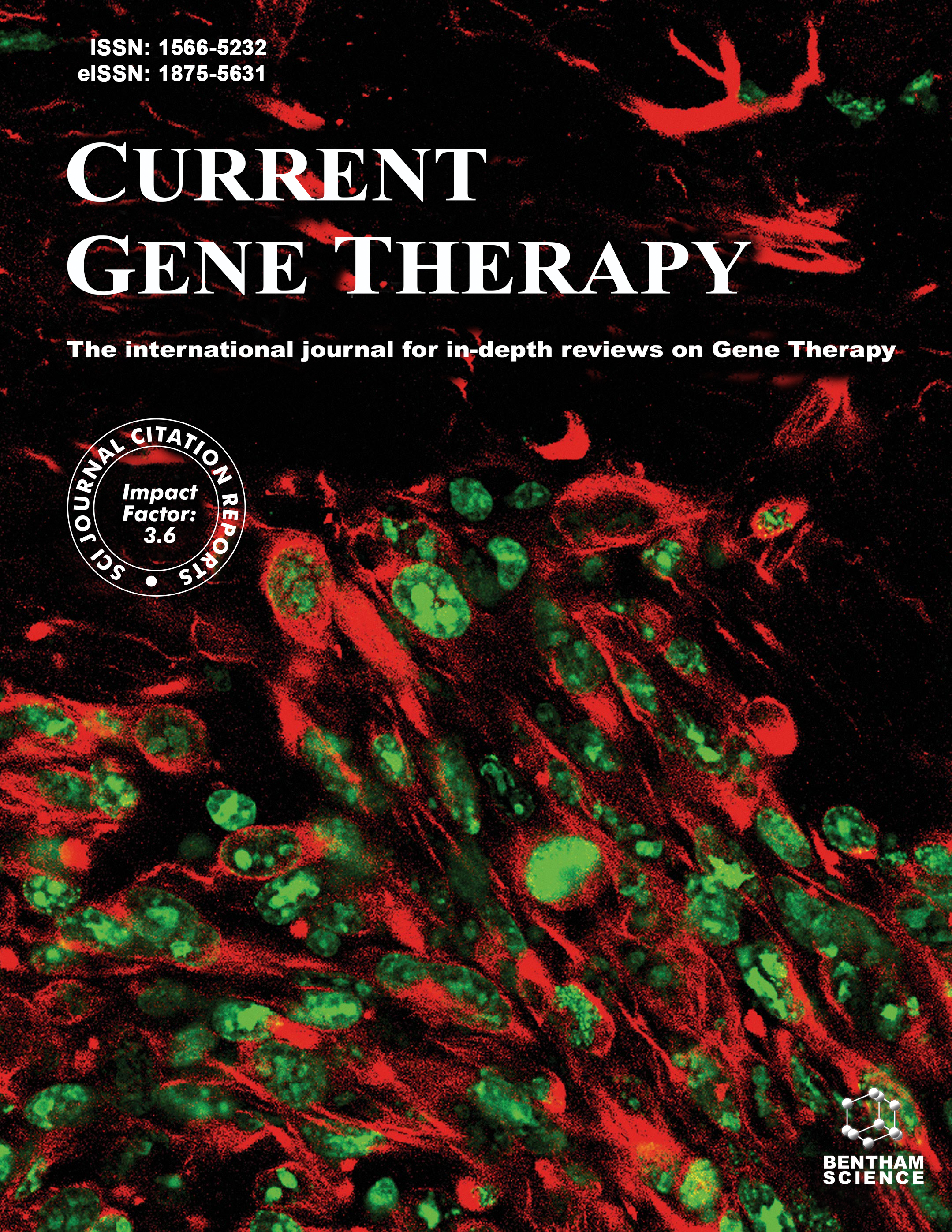- Home
- A-Z Publications
- Current Gene Therapy
- Previous Issues
- Volume 15, Issue 5, 2015
Current Gene Therapy - Volume 15, Issue 5, 2015
Volume 15, Issue 5, 2015
-
-
CFTR Inactivation by Lentiviral Vector-mediated RNA Interference and CRISPR-Cas9 Genome Editing in Human Airway Epithelial Cells
More LessAuthors: Jessica Bellec, Marc Bacchetta, Davide Losa, Ignacio Anegon, Marc Chanson and Tuan Huy NguyenBackground: Polarized airway epithelial cell cultures modelling Cystic Fibrosis Transmembrane conductance Regulator (CFTR) defect are crucial for CF and biomedical research. RNA interference has proven its value to generate knockdown models for various pathologies. More recently, genome editing using CRISPR-Cas9 artificial endonuclease was a valuable addition to the toolbox of gene inactivation. Methods: Calu-3 cells and p Read More
-
-
-
Molecular Imaging to Monitor Repair of Myocardial Infarction Using Genetically Engineered Bone Marrow-Derived Mesenchymal Stem Cells
More LessHeart tissue has a diminished ability to repair after myocardial infarction (MI). Bone marrow- derived mesenchymal stem cells (BMSCs) have been used effectively to heal damaged tissue after MI. Hypoxia-inducible factor-1α (HIF-1α) can induce transcription of numerous pro-angiogenic genes and enhance stem cell survival. Here, we investigated whether HIF-1α-transduced BMSCs could enhance tissue repair after MI, and com Read More
-
-
-
Folate-conjugated Chitosan-poly(ethylenimine) Copolymer As An Efficient and Safe Vector For Gene Delivery in Cancer Cells
More LessAuthors: Wing-Fu Lai and Marie C. LinFolic acid (FA) has high affinity to folate receptors (FRs), which have three isoforms: FRα, FRβ and FRγ. Among them, FRα is a tumor specific receptor, as it is frequently over-expressed in diverse malignancies but not in normal tissues. In this study, we have conjugated FA to a chitosan-poly(ethylenimine) copolymer, and have confirmed the low cytotoxicity of the product (namely “CP1.3K-FA”) in cancer cells. The transfec Read More
-
-
-
Biodistribution of LV-TSTA Transduced Rat Bone Marrow Cells Used for “Ex-vivo” Regional Gene Therapy for Bone Repair
More Less“Ex vivo” regional gene therapy using lentiviral (LV) vectors to over-express bone morphogenetic protein 2 (BMP-2) is an effective way to enhance bone healing in animal models. Here, we evaluated two different “ex vivo” approaches using either “same day” rat bone marrow cells (SDRBMCs) or cultured rat bone marrow cells (C-RBMCs), both transduced with a LV based two-step transcriptional activation system overexpressin Read More
-
-
-
Bifunctional siRNA Containing Immunostimulatory Motif Enhances Protection Against Pandemic H1N1 Virus Infection
More LessAuthors: Gaurav Joshi, Paban K. Dash, Ankita Agarwal, Shashi Sharma and Manmohan ParidaRationale: The first influenza pandemic of 21st century was attributed to a novel quadruple reassortant H1N1 virus that emerged in 2009. Currently available therapies for influenza have drugresistant. Therefore, there is a need to develop new generation immunotherapeutic antiviral strategy. This study described the efficacy of a novel bifunctional immunostimulatory siRNAs against H1N1pdm swine flu virus by targeting the Nu Read More
-
-
-
Therapy for Dominant Inherited Diseases by Allele-Specific RNA Interference: Successes and Pitfalls
More LessAuthors: Delphine Trochet, Bernard Prudhon, Stephane Vassilopoulos and Marc BitounRNA interference (RNAi) is a conserved mechanism for post-transcriptional gene silencing mediated by messenger RNA (mRNA) degradation. RNAi is commonly induced by synthetic siRNA or shRNA which recognizes the targeted mRNA by base pairing and leads to target-mRNA degradation. RNAi may discriminate between two sequences only differing by one nucleotide conferring a high specificity of RNAi for its target mRNA. Read More
-
-
-
Current Genome Editing Tools in Gene Therapy: New Approaches to Treat Cancer
More LessGene therapy suggests a promising approach to treat genetic diseases by applying genes as pharmaceuticals. Cancer is a complex disease, which strongly depends on a particular genetic make-up and hence can be treated with gene therapy. From about 2,000 clinical trials carried out so far, more than 60% were cancer targeted. Development of precise and effective gene therapy approaches is intimately connected with achi Read More
-
Volumes & issues
-
Volume 25 (2025)
-
Volume 24 (2024)
-
Volume 23 (2023)
-
Volume 22 (2022)
-
Volume 21 (2021)
-
Volume 20 (2020)
-
Volume 19 (2019)
-
Volume 18 (2018)
-
Volume 17 (2017)
-
Volume 16 (2016)
-
Volume 15 (2015)
-
Volume 14 (2014)
-
Volume 13 (2013)
-
Volume 12 (2012)
-
Volume 11 (2011)
-
Volume 10 (2010)
-
Volume 9 (2009)
-
Volume 8 (2008)
-
Volume 7 (2007)
-
Volume 6 (2006)
-
Volume 5 (2005)
-
Volume 4 (2004)
-
Volume 3 (2003)
-
Volume 2 (2002)
-
Volume 1 (2001)
Most Read This Month
Article
content/journals/cgt
Journal
10
5
false
en

Most Cited Most Cited RSS feed
-
-
New Hope for Intervertebral Disc Degeneration: Bone Marrow Mesenchymal Stem Cells and Exosomes Derived from Bone Marrow Mesenchymal Stem Cell Transplantation
Authors: Xiao-bo Zhang, Xiang-yi Chen, Jin Qi, Hai-yu Zhou, Xiao-bing Zhao, Yi-cun Hu, Rui-hao Zhang, De-chen Yu, Xi-dan Gao, Ke-ping Wang and Lin Ma
-
- More Less

